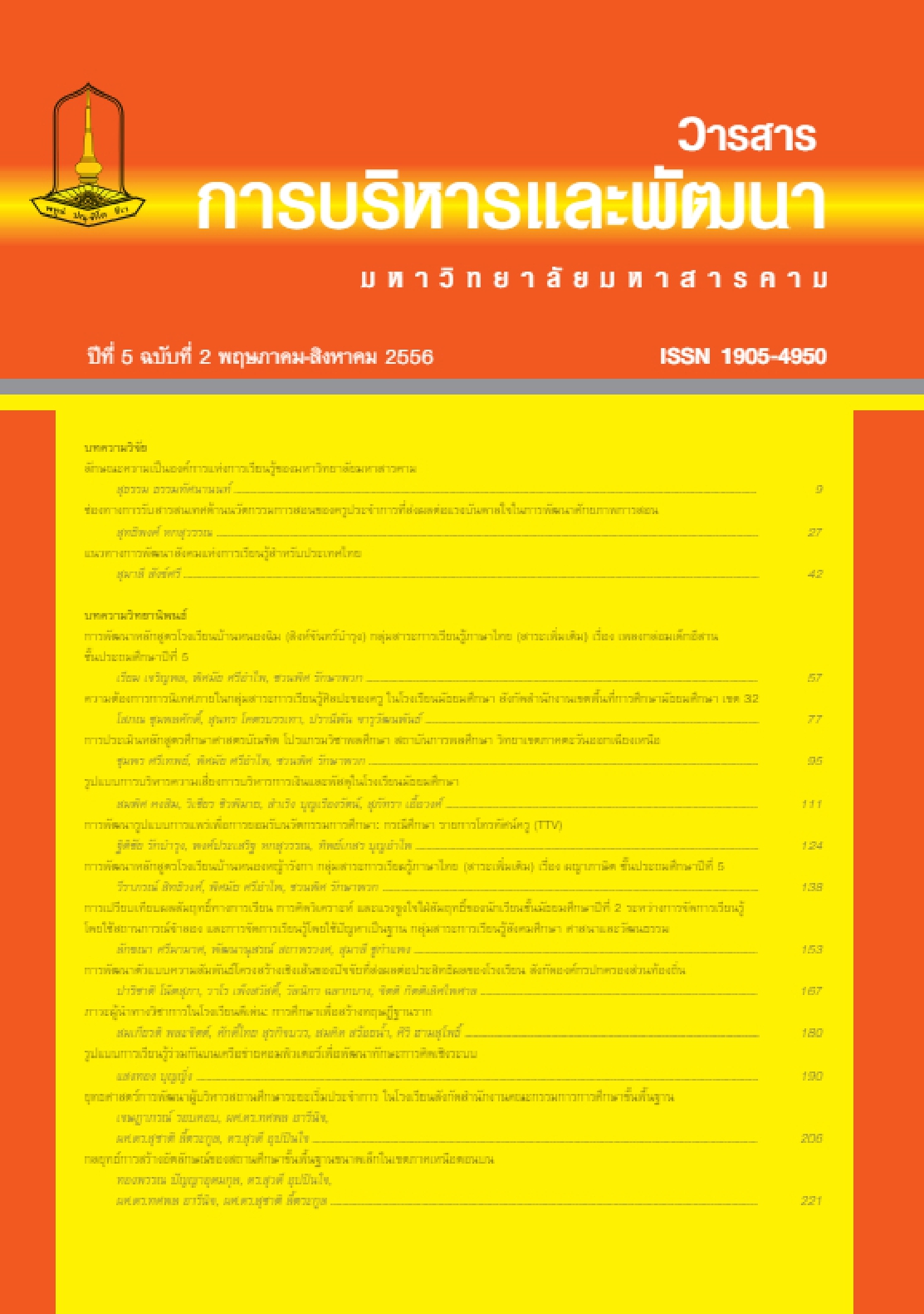Comparisons of Learning Achievement, Analytical Thinking, and Achievement Motivation of Mathayomsueksa 2 Students Between Using Simulation Approach and Problem Base Learning for social studies, Religion and Culture Learning Strands
Main Article Content
Abstract
The purposes of this research were: (1) to develop plans for learning organization using the simulation approach and Problem based learning approach of Mathayomsuksa 2 level with a required efficiencies of 80/80, (2) to find out effectiveness indices of those two mentioned plans, (3) to compare learning achievement, analytical thinking and achievement motivation of the students who learned using the two different approaches. The sample used in this study consisted of 68 Mathayomsueksa 2 students attending Potisaenvitthaya school in Kusuman district, under the Office of Secondary Educational Service Area Zone 23 in the second semester of the academic year of 2011, obtained using the cluster random sampling technique. They were randomly divided into two experimental groups, 33 and 35 students, and were randomly assigned in different of two experimental groups. The instruments used for the study comprised of: (1) 2 types of learning plans as mentioned 8 plans each, for 16 hours per each approach ; (2) a 30 item of learning achievement test with a discriminating powers ranging 0.33 - 0.88, and a reliability of 0.72 ; (3) 25-item analytical thinking ability test with difficulties ranging 0.28 - 0.43, discriminating powers ranging 0.26 - 0.68, and a reliability of 0.80 ; a 20-item scales of achievement motivation with discriminating powers ranging 0.66 - 0.88, and a reliability of 0.84. The statistics used for analyzing data were percentage, mean, standard deviation, and F-test (One-way MANOVA) was employed for testing hypotheses.
The results of the study were as follows:
1. The plans of Simulation learning approach and Problem-based learning approach had efficiencies (E1 /E2 ) of 83.59/82.73 and 81.56/81.05 respectively.
2. The plans of Simulation learning approach and Problem-based learning approach had the effectiveness indices of 0.6890 and 0.6694, indicating that these students progressed their learning at 68.90 and 66.94 percentage respectively.
3. The students who learned using the Simulation learning approach showed higher analytical thinking ability than the group who learned using problem-based learning approach at the level of significance .003, but they did not show different of learning achievement, and achievement motivation.
Downloads
Article Details
References
Department of Academic. (2001). Curriculum of Basic Education B.E.2544. Bangkok: The Express Transportation Organization of Thailand Printing.
Nirat Jantharajit. (2010). Learning For Thinking. Maha Sarakham: Maha Sarakham University Publishing.
Neatra Moondoung. (2007). The Development of Lesson Plan for Simulations Learning, Entitled Democratic Approach in Social Studies, Religion and Culture Content Strands of Mathayomsuksa Three Level. Independent Study for Master of Education Degree. Mahasarakham: Mahasarakham University.
Ong, Ai-Choo and Borich, Gary D. (2006). Teaching Strategies That Promote Thinking: Models and Curriculum Approaches. Singapore: McGraw-Hill Education.
Poungrat Boonyanurat. (2001). New Directions of Thai Teachers. Bangkok: Project of Professional Development in Higher Education, Department of Higher Education, Faculty of Education,
Rheanthong Sudsang. (2007). The Comparison of Learning Outcomes of Mathayomsuksa One Students Between Using Problem-Based Learning and Simulations Learning Approach, Entitled Moral and Ethics, For Social Studies, Religion and Culture Content Strands. Thesis for Master of Education Degree. Mahasarakham: Mahasarakham University.
Severiens, Sabine E. (2009). “Academic and Social Integration and Study Progress in Problem Based Learning,” Dissertation Abstracts International. 58(1): 59-69 ; July.
Supaporn Thatsakorn. (2011). The Comparison of Learning Achievement, Analytical Thinking Abilities, and Emotional Intelligence of Mathayomsuksa Two Students, Between Using Role PlayingApproach and Problem-Based Learning Approach, Entitled Law of Day Life. Thesis for Master of Education Degree. Mahasarakham: Mahasarakham University.
The Office of Basic Education Commission. (2008). The Core Curriculum of Basic Education B.E. 2551. Bangkok: The Agricultural Co-operation of Thailand Publishing.
Tissana Khammanee. (2001) Strategies of Teaching. Bangkok: Chulalongkorn University Publishing.
Tissana Khammanee. (2002). The Students – Centered Learning. 5th edition. Bangkok: Chulalongkorn University Publishing.


